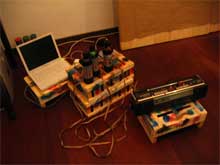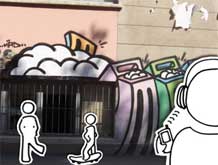Third project from the Interaction Design Institute Ivrea final show (see dedicated category).
Chia Ying Lee's Sonic Graffiti invites urban artists to collaborate and create music together, while allowing the passersby to enjoy it as well.
A system of devices enables graffiti artists to create and geo-tag music in the urban space with real spray cans:


- The sound cap has to be snapped on the top of spray cans to spray out sounds and do simple sound manipulations with gestures. Users create music by overlaying/remixing various paint/sounds from the caps. Each cap can store up to 4 sounds in its memory card. They can be loaded from computers or portable devices like iPod, mobile phone, etc. Gestures to manipulate sound include fade in/out and scratch. Several artists spraying at the same time can create a sound composition.
- The controller is used for listening to the music with earphones when creating, and positioning sounds. It also comes with a recording part can be used for collecting sound samples from the city.
- The Boom box provides a shared listening experience for a group of creators in the public. Collaborations can be achieved both synchronously and asynchronously.
- Audiences can download a dedicated software player to install in mobile devices. Each graffiti is a small radio station. The player tunes into the music of the nearest sonic graffiti automatically while you go through the city. You can also mark the locations of music you like, hence make a personal sonic graffiti map.
This project gives graffiti audio meanings. It may change people' viewpoint about graffiti. The music can also serve as the soundtrack reflecting the vibes of the city.
More details on Chia-Ying Lee's thesis blog. My images of her installation.
Related: spatial graffiti, Wearable inkjet printer for street art, Audio messages left in space, Graffiti Analysis projections, Hektor the graffiti machine, emergency spray can, Bench'Mark

